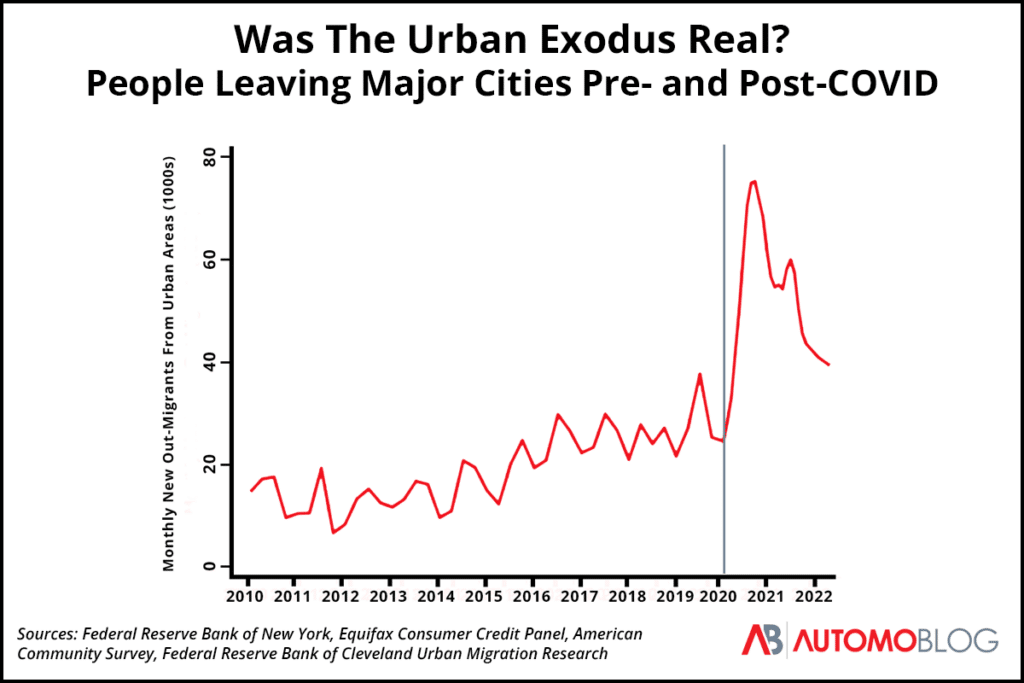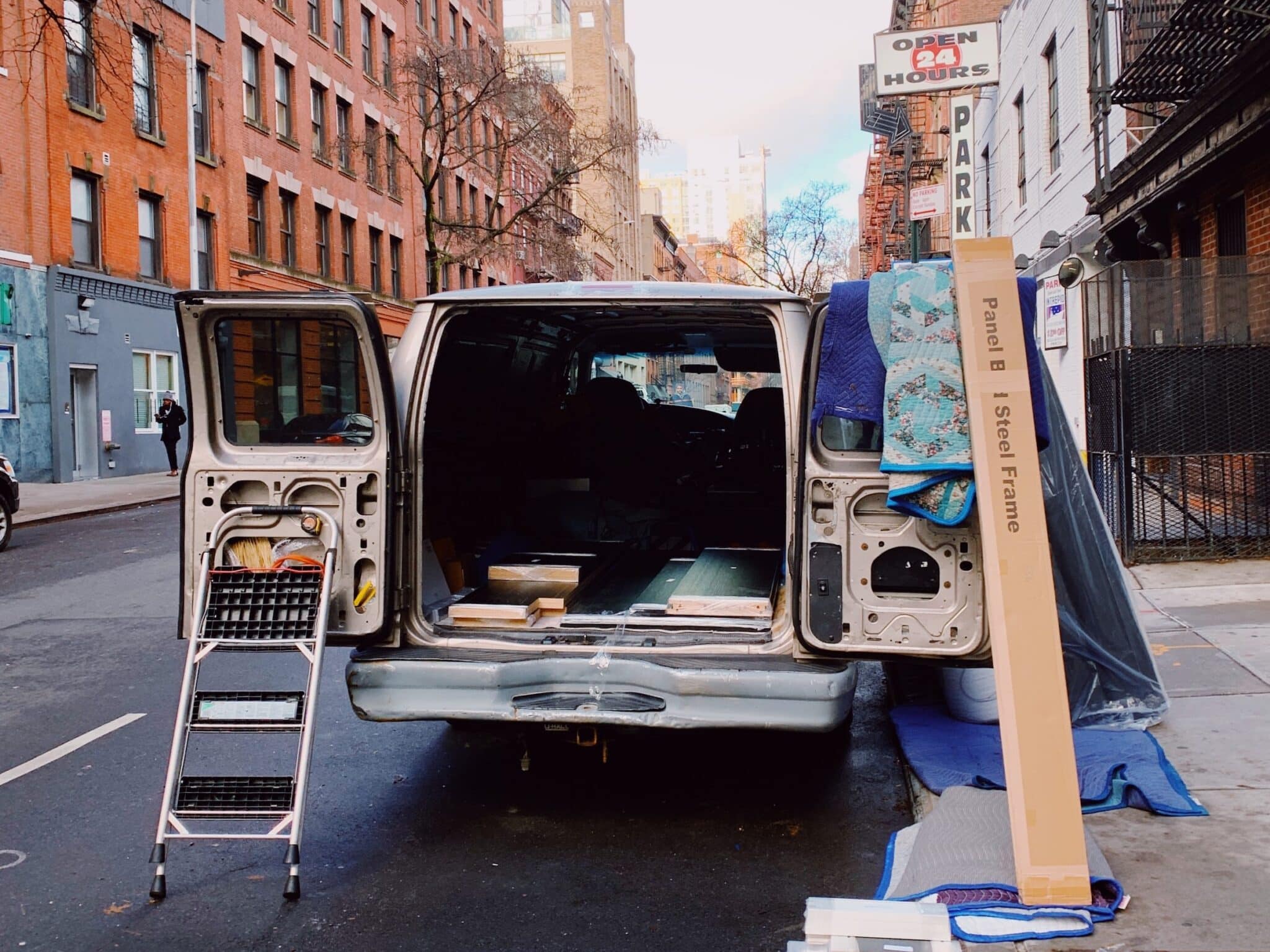Affiliate Disclosure: Automoblog and its partners may earn a commission when you use the services or tools provided on site. These commissions come to us at no additional cost to you. See our Privacy Policy to learn more.
The story of an “urban exodus” was widely circulated following the onset of the COVID-19 pandemic in 2020. That narrative suggested that people moved en masse from large urban centers like New York City, San Francisco, and Los Angeles to smaller cities and more rural areas after the pandemic set in. But how substantial – and how enduring – that trend was is a more complex story.
To get an insider’s perspective, Automoblog spoke with several professionals who could offer a more personal take based on firsthand experience – including Tsvetelin Savov, CEO of SGT Auto Transport, one of the country’s most popular car shipping companies. During our interview, Savov shared his observations about where people have been moving since the beginning of the pandemic, and spoke about how the car shipping industry as a whole has changed in the wake of COVID-19.
“In the initial months, there was a significant increase in the number of vehicle shipments to smaller, rural areas as people began moving out of larger metropolitan areas and into more isolated locations,” he recounted.
People Did Move From Bigger Cities to Smaller Ones
Over the last three years, the narrative that people left big cities to move to smaller neighborhoods during and after COVID-19 circulated widely in major U.S. media outlets. While there are nuances to that narrative, the fundamental conclusion has some validation.
The Federal Reserve Bank of Cleveland conducted a periodic study on the topic, collecting and synthesizing data from the Federal Reserve Bank of New York Consumer Credit Panel/Equifax Data, American Community Survey, National Association of Realtors, and other entities. The Q1 2021 edition of the study compared “migrations” from the first year of the pandemic to those of the three years prior.
The study defines four categories of locales:
- High-cost, large metropolitan areas with populations greater than 2 million (hereto referred to as “large expensive metros”)
- Lower-cost, large metropolitan areas with populations greater than 2 million (hereto referred to as “less expensive large metros”)
- Mid-size metropolitan areas with populations between 500,000 and 2 million (hereto referred to as “mid-size metros”)
- Small metro areas with populations of fewer than 500,000, including rural areas and towns (hereto referred to as “smaller cities, towns, and rural areas”)
Between Q2 2020 and Q1 2021, smaller cities, towns, and rural areas experienced an increase in move-ins from every other category compared to the previous three years. These areas also saw the largest increase in move-ins – at 13.6% – from large, expensive cities of any category.
Mid-size cities saw a decrease in move-ins from smaller cities, towns, and rural areas in the first year of the pandemic. Yet they saw an increase from every other category, including a 13.4% increase in move-ins from large, expensive cities.
Professionals Say the Data Aligns With Their Experience
The data paints a relatively clear picture of these moving trends. However, that picture can often be incomplete when based on data alone.
Savov’s job has given him unique and direct insight into moving patterns in the U.S. When we spoke to him, he told us that his personal experience and his company’s data more or less lines up with what we found in our research.
“We saw an increase in shipments to older towns and cities, as well as more remote locations throughout the country,” he said. “This was likely due to the desire for more space and distance from others during the early stages of the pandemic.”
The trend is something real estate agent Yannick Lloyd can attest to. Lloyd is based in North Carolina’s “Triangle” region – an area that includes Chapel Hill, Durham, Raleigh, and several smaller towns and suburbs in between. The Triangle was one of several less expensive large metros that saw significant growth in the early stages of the pandemic.
As a real estate agent, Lloyd works closely with people who move into the area. This gives him a more intimate insight into why people made the decision to move to the Triangle. He said that for most people, cost was one of the biggest driving factors.
“Relocation [to the Triangle] from larger cities has definitely increased in recent years,” Lloyd told Automoblog. “Economic shifts made people reconsider the value of larger cities. Affordability is still a large selling point for the Triangle. Although prices have increased in the area, homes in the Triangle are much more affordable than larger cities in the Tri-State Area and the West Coast”
Move Outs Also Provide Insight
There was an increase of 9.4% in moves to less expensive large cities from large, expensive cities during the period. However, move-ins from every other category decreased.
But the story isn’t just about where people from larger cities were moving to during the period, it’s also about where they were not moving to these cities from. There was a slight positive change in moves from high-cost large metro areas with populations greater than 2 million to other metro areas in that category.
However, there was a significant drop in moves to large, expensive cities from every other category. This includes a 6.1% decrease in the number of people moving to these cities from smaller cities, towns, and rural areas.
Savov said that his internal auto shipping data supports this part of the narrative as well. “This trend [of increased shipments to towns and rural areas] continued for much of the year [2020], with many individuals and families seeking out less crowded areas to live and work in.”
Lloyd pointed out that many of these moves have been made possible by the ability to work from home. He said that this newfound capability, combined with rising costs, has made moves out of big cities an attractive option for many people.
“More people have had the freedom to work remotely since the pandemic,” said Lloyd. “Cost of living has become a priority since 2020 due to inflation.”
The Narrative of an “Urban Exodus” Is Complicated
This set of data compiled by the Federal Reserve Bank of Cleveland from the first year of the pandemic provides a compelling argument for the popular narrative of an “urban exodus,” but it doesn’t tell the whole story. Another way journalists and researchers track moving data is through monitoring U.S. Postal Service (USPS) change-of-address forms.
This data adds an important facet to the story. While it indicated a slight uptick in the submission of permanent change-of-address forms, it also revealed a far greater increase in the submission of temporary change-of-address forms.
These trends suggest that many of the moves that happened in the first year of the pandemic were not permanent moves. So while people were leaving large, expensive cities, many of them were doing so with the idea that they would return.
The Trend of Moving Away From Large, Expensive Cities Slowed Down Quickly
Just as many of the moves at the beginning of the pandemic were temporary, so was the trend of people moving out of large, expensive metros. Or, at least that’s what an updated version of the same Federal Reserve Bank of Cleveland data set would suggest.

The updated data that includes Q4 2022 shows that, while out-migration from urban neighborhoods indeed spiked in 2020, the number of people moving out of those areas dropped significantly in 2021 and 2022. This could be, in part, because people who were inclined to leave already did so in 2020. However, it also goes against the narrative of an “urban exodus” as a lasting trend or cultural shift.
COVID Has Had a Major Impact on the Car Shipping Industry in Specific
The auto transport industry is one of many that has seen significant change since the onset of the pandemic. Savov told Automoblog that for SGT, that change has been a positive one as far as business is concerned.
He speculated that the positive impact to his business in specific is due to several reasons. One of those is that cars are more of a necessity in the smaller cities and rural areas – that people moved to starting in 2020 – than they are in the large cities they moved from.
“[The pandemic] has resulted in an increased need for car shipping services, as people have needed to move their vehicles long distances to their new locations,” Savov said. “This has been particularly true for families and individuals who are looking to move to more isolated areas.”
Mandatory restrictions, quarantines, and other government policies enacted in response to COVID have also played a role, according to Savov. He said that these policies made it more difficult to drive through multiple states, making car shipping a more attractive option for many.
“With the government’s requirements and restrictions on travel, many people were unable or unwilling to drive their vehicles long distances,” said Savov. “As a result, there has been an increase in demand for car transport services as more individuals and families have turned to auto transport as a safer and more convenient alternative.”
Car Shipping Post-COVID: What We’ve Learned
The idea that COVID-19 “changed everything” is now perhaps as cliche as the phrase “new normal” was by the end of 2020. But the changes in moving patterns that have followed the onset of the pandemic offer a lot of perspective on how we responded to the situation. They also provide insight into how we may respond to similar situations in the future.
The same density that created opportunities and drew people into cities also made those places dangerous and difficult to live in as COVID began to spread. Many of those who were able to leave those cities did. And many of those moves were possible because of the ability to move away from offices without leaving a job.
Whether people choose to return to large cities in the coming years remains to be seen. Based on the data in our research and the experience of people like Savov, that shift back to urbanizing may already be underway.
“In the last few months, we have started to see things return to a more normal pattern,” said Savov. “The number of vehicle shipments to larger metropolitan areas has started to increase again as life gets back to normal.”
However, if the COVID-19 pandemic and its myriad and substantial effects on people and industry have made anything clear, it’s that things can change dramatically and without warning.


